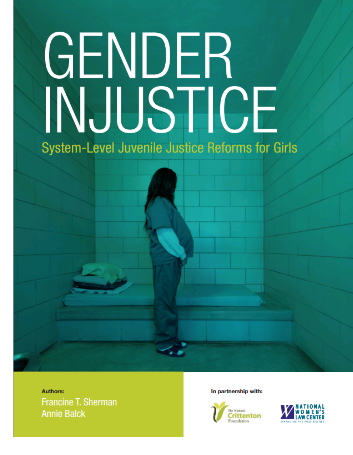
Written by Jeannette Pai-Espinosa, courtesy of JJDPA Matters Blog
Today, October 29, we join together to recognize Girls Justice Day because sadly, despite decades of attention, the proportion of girls in the juvenile justice system has increased. At the same time,their challenges have remained remarkably consistent, resulting in deeply rooted, systemic gender injustice.
Every day in this country, girls who are survivors of violence, sexual abuse, neglect, and family dysfunction are driven into the justice system. Too often, it’s because we criminalize the actions they take to protect themselves and to deal with their trauma. Girls are rarely detained for offenses that cause a risk to public safety—they are significantly more likely to face arrest for “status offenses,” which are actions that would not be considered a crime if they were adults, such as running away.
New data recently released by the Office of Juvenile Justice and Delinquency Prevention shows that despite declines in overall youth incarceration, the number of system-involved girls is increasing and those girls are disproportionately girls of color. In fact, data that show 61 percent of incarcerated girls are girls of color, and that black girls are twice as likely as white girls to be incarcerated.
For juvenile justice reform to be truly effective, it must consider the context of girls’ lives, address their needs, and attack the disproportionate detention of girls of color. The good news is that momentum for change is building, even at the highest levels of our government.
On October 28, The White House Council on Women and Girls and the Domestic Policy Council’s Urban Affairs, Justice and Opportunity team hosted an all-day forum called “Girls of Color and Intervening Public Systems: How Can Communities Interrupt the Sexual Abuse-to-Prison Pipeline?”
This convening focused attention on the social impact of trauma and the connection between adverse childhood experiences—such as sexual abuse, young motherhood, commercial sex trafficking—and juvenile justice system engagement. As President Obama noted in his September 19th speech to the Congressional Black Caucus, we must change the ways our nation supports women and girls who are most at-risk, including many women and girls of color.
During the meeting, Vanita Gupta, Principal Deputy Assistant Attorney General, stated, “Protecting young women and girls from sexual assault and abuse is a fundamental right. Federal law requires that our schools protect our students from sexual abuse. Schools are too often responding with suspension expulsion and arrest.”
She also told the young women who attended: “You are not alone.”
Fran Sherman, speaker and author of the recent report, Gender Injustice, noted that, “Everyday girls with trauma enter the juvenile justice system for behavior related to their trauma and that school failure disproportionately drives girls of color into the justice system.”
During a panel of Federal officials OJJDP Administrator Robert Listenbee announced the release of the OJJDP Policy Guidance on Girls in Juvenile Justice. The policy statement includes recommendations that include a ban on status offenders being placed in the juvenile justice system and a phase out of the use of valid court orders. OJJDP believes that the needs of girls must be addressed in a developmentally appropriate manner.
We couldn’t agree more.
Which is why we are excited that yesterday also brought the announcement of the first recipients of the National Girls Initiative’s Innovation Awards, a program designed to spotlight and support creative efforts to advance systems-level juvenile justice reforms for girls. Support for the seven recipients comes from a mix of government and philanthropic funds and will drive new resources to state, local and tribal efforts to address girls’ needs, and to share information on evidence-based practices that are trauma-informed and gender and culturally responsive. The National Girls Initiative is a collaborative effort of both American Institutes for Research (AIR) and The National Crittenton Foundation (TNCF); it works to elevate the voices of girls and their families as partners in reforming the juvenile justice system.
For me the highlight of the day at the White House was the panel of youth advocates from Girls for Gender Equity in New York City. Nowhere is the call to action for reform more clear, passionate and commanding than through the voices of young women survivors. Possessed with the courage born of commitment, and compassion for the girls yet to come, they share the reality of their lives as evidence of the need for change. As leaders, they teach us that we must invest of ourselves to achieve true change.
So today, on Girls Justice Day, while it appears that movement and transformation is near, we must stand with these young women leaders to continue to press forward for reform that addresses the needs and potential of girls in or at risk of entering the juvenile justice system. This includes the long overdue passage of reauthorization of the JJDPA.
Jeannette Pai-Espinosa is the President of The National Crittenton Foundation and the Co-Director of the National Girls Initiative of OJJDP. Additionally, she is chair of the National Foster Care Coalition and a member of the Women’s Services Advisory Committee for SAMSHA.